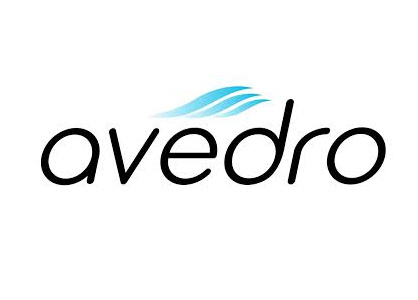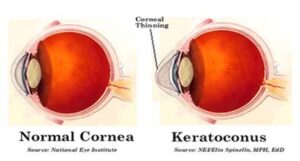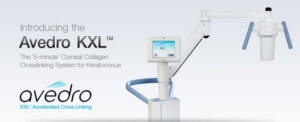
At Kapil Eye Hospital, we perform Corneal Collagen Crosslinking with Riboflavin (C3R) Treatment. Our sophisticated ophthalmologists are laced with modernized equipments & technologies to detect and cure the disease. This revolutionary procedure was first introduced in the month of September 2006 and C3R is the only procedure that is known to mankind for efficient cessation of dreaded Keratoconus.
Corneal collagen cross-linking is a medical procedure that combines the use of ultra-violet light and riboflavin eye drops. The procedure was first developed by Dr. Theo Seiler, Dr. Eberhard Spoerl and Dr. Gregor Wollensak in the late-1990s as a means of stabilizing the cornea to limit the progression of keratoconus1 and has been widely adopted as a conservative treatment for the condition as well as for iatrogenic ectasia.
Standard Cross-Linking Procedure
Total treatment time = 60 minutes
- Riboflavin (vitamin B2) drops are applied to the cornea (30 minute riboflavin pre-soak)
- The cornea is exposed to ultra violet light (30 minute irradiation with 3mW/cm2 365nm UVA)
- The light causes the riboflavin to fluoresce, leading to the formation of bonds between collagen molecules or collagen cross-linking
Accelerated Cross-Linking Procedure
Total treatment time = 14 minutes or less
- Riboflavin (vitamin B2) drops are applied to the cornea (10 minute riboflavin pre-soak)
- The cornea is exposed to ultra violet light (4 minute irradiation with 30mW/cm2 365nm UVA)
- The light causes the riboflavin to fluoresce, leading to the formation of bonds between collagen molecules or collagen cross-linking2
The ophthalmology community has recently seen a marked increase in the prominence of corneal collagen cross-linking as a treatment strategy for progressive keratoconus and post-LASIK ectasia. As a first-line treatment, the greatest aim of cross-linking is to reduce and stop keratoconus progression in the early phase of the condition. This interest has arisen from a body of evidence documenting the biomechanical and cellular changes induced by cross-linking. The findings of this research provide a rationale for its use in keratoconus to halt the progression of the disease. A rapidly growing number of clinical publications suggest a consistent stabilizing effect of cross-linking along with a variable improvement in corneal shape and visual function in some patients. As a first-line treatment, the greatest aim of cross-linking is to reduce and stop keratoconus progression in the early phase of the condition, and to treat the progressive vision loss the condition may cause, potentially leading to corneal transplantation.

C3R treatment procedure brings a ray of hope for the patients suffering from this disease who pray for perfect vision. Keratoconus is one of the most eerie diseases and requires proper attention because this disease unremittingly grows at the time of very young age moreover, does not reflects any symptoms that is what makes it difficult to detect. Have a look at the image how Keratoconus affects the eye.
Why Should I Choose C3R Over Corneal Transplant?
C3R is the best possible treatment to tackle and cure Keratoconus. It is a non-surgical procedure and has shown proven successful records. It allows the patients to get rid of the disease once and for all which states results are permanent.
- Unlike corneal transplant it C3R does not demands donor.
- Pain-free procedure
- No stitches
- No heavy precautions after the treatment
- Swiftly recovery
The procedure takes only one hour and there are no side effects proving this treatment equivalent to a gift from god.
Keratoconus thins and weakens the surface of the cornea causing a bump outwards, which
furthermore gives blurriness in sight. During this treatment ophthalmologist insert riboflavin solution into the eye while unveiling it to ultra high frequency light. The process makes the surface of the cornea thick and strong again resulting re-attached to the eyeball, there goes the bulge.



 +91 9896259777
+91 9896259777